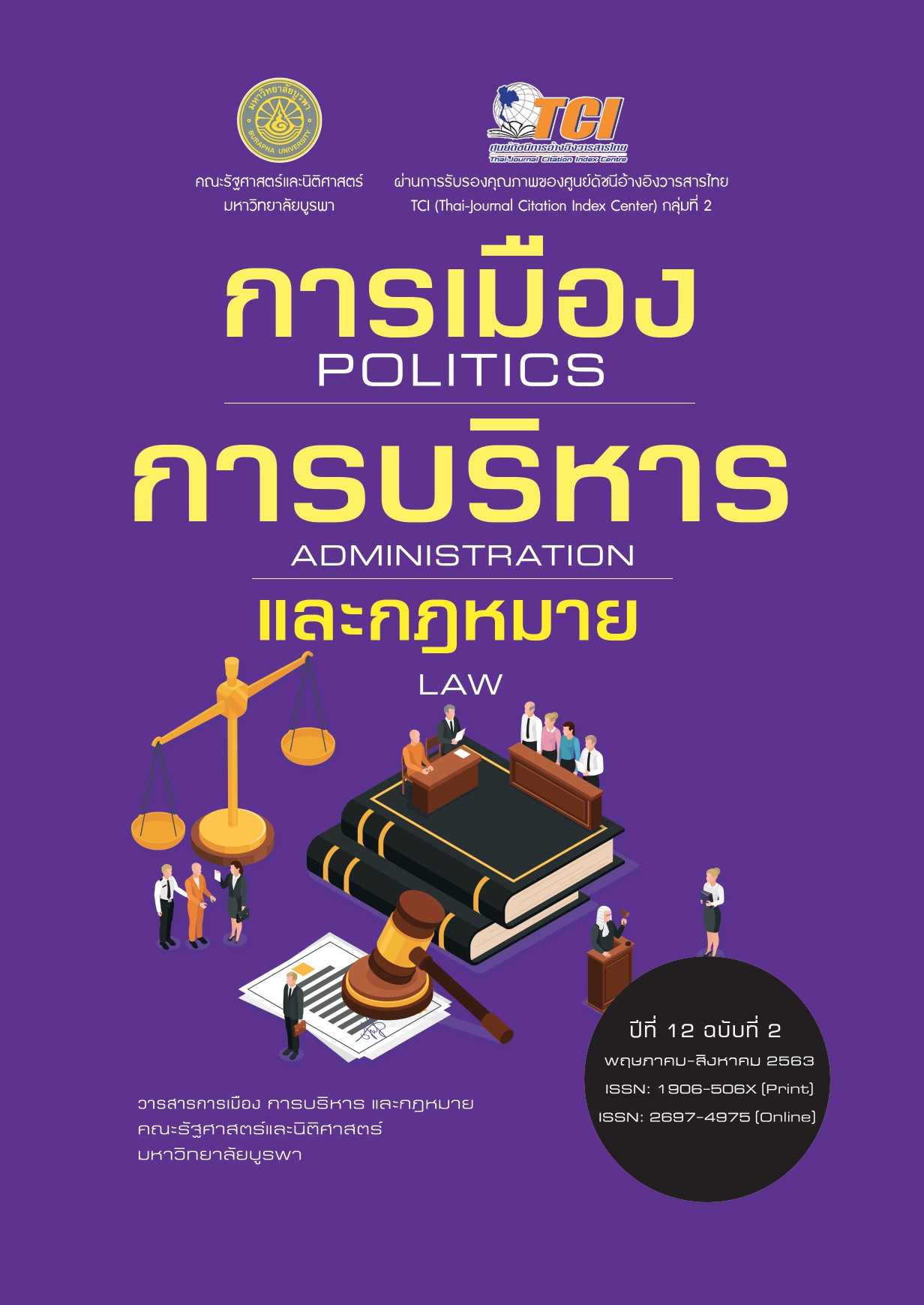The Structural Influence of Organizational Culture on the Competitive Advantage of Entrepreneurs in the Air - Conditioner Production Businesses in Bangkok
Keywords:
Organizational culture, Entrepreneurship, Knowledge management, Competitive advantageAbstract
This study aimed to investigate: (1) levels of organizational culture, entrepreneurship, knowledge management, and competitive advantage; (2) the influences of the mediated variable of the entrepreneurship as a correlated variable between organizational culture and competitive advantage; and (3) the influences of the mediated variable of the knowledge management as a correlated variable between organizational culture and competitive advantage of air-conditioner production businesses in Bangkok. Samples in the study were 106 entrepreneurs in the air-conditioner production businesses in Bangkok. The research instruments in the study were a questionnaire and statistics used in the study were percentage, means, standard deviation, and the analysis of the structural equation modeling (SEM). The results of the study revealed that: (1) the entrepreneurs in the air-conditioner production businesses in Bangkok had averaged levels of organizational culture, entrepreneurship, knowledge management, competitive advantage at the high level; (2) the entrepreneurship was a mediated variable which was correlated with the organizational culture and the competitive advantage; and (3) the knowledge management was a mediated variable which was correlated with the organizational culture and the competitive advantage. Therefore, this study ascertained that the outcomes of different studies could be established as the fundamental competitive advantage, depending on the entrepreneurship and the knowledge management to efficacy within the organizations.
References
กฤตวรรณ พริ้งสกุล. (2558). ปัจจัยเกื้อหนุนกลยุทธ์การสร้างความได้เปรียบในการแข่งขันธุรกิจการสร้างข่ายสายเคเบิลใต้ดินในประเทศไทย. วารสารวิชาการ มหาวิทยาลัยกรุงเทพธนบุรี, 3(2), 97-107.
ฐิติพร วรฤทธิ์. (2550). ความสัมพันธ์ระหว่างคุณภาพระบบสารสนเทศทางการบัญชีความได้เปรียบทางการแข่งขันและความสําเร็จในการดําเนินธุรกิจ SMEs ในประเทศไทย. วิทยานิพนธ์บัญชีมหาบัณฑิต, สาขาการบัญชี, มหาวิทยาลัยมหาสารคาม.
ทิพวรรณ หล่อสุวรรณรัตน์. (2552). องค์กรแห่งการเรียนรู้: จากแนวคิดสู่การปฎิบัติ (พิมพ์ครั้งที่ 5). กรุงเทพฯ: รัตนไตร.
ธัญนันท์ บุญอยู่. (2558). อิทธิพลคั่นกลางแบบอนุกรมของทุนทางปัญญาและการเป็นผู้ประกอบการในการถ่ายทอดวัฒนธรรมองค์การสู่ผลการดำเนินงานสำหรับอุตสาหกรรมต่อตัวถังรถโดยสาร. ดุษฎีนิพนธ์บริหารธุรกิจดุษฎีบัณฑิต, สาขาบริหารธุรกิจ, มหาวิทยาลัยรามคำแหง.
ธัญนันท์ บุญอยู่. (2561). อิทธิพลของความสามารถทางนวัตกรรมในฐานะตัวแปรคั่นกลางที่ถ่ายทอดอิทธิพลของวัฒนธรรมองค์การ การมุ่งเน้นการตลาด การจัดการความรู้และการเป็นผู้ประกอบการสู้ความได้เปรียบในการแข่งขันอย่างยั่งยืน. วารสารดุษฎีบัณฑิตทางสังคมศาสตร์, 8(ฉบับพิเศษ), 44-62.
นวพร สังวร และสุดาพร สาวม่วง. (2555). กลยุทธ์การสร้างความได้เปรียบทางการแข่งขันในการส่งออกยางพาราไทยสู่ประชาคมเศรษฐกิจอาเซียน. วารสารสมาคมนักวิจัย, 19(1), 111-122.
พรทิพย์ บุญทรง, ประชา ตันเสนีย์ และนงลักษณ์ ลัคนทินากร. (2559). รูปแบบการจัดการความรู้เพื่อความได้เปรียบในการแข่งขันของผู้ประกอบการตลาดน้ำลำพญา จังหวัดนครปฐม. นครปฐม: มหาวิทยาลัยเทคโนโลยีราชมงคลรัตนโกสินทร์.
ศูนย์วิจัยกสิกรไทย. (2560). บทวิเคราะห์แนวโน้มธุรกิจ. วันที่ค้นข้อมูล 10 ธันวาคม 2561, เข้าถึงได้จาก https:// kasikornresearch.com/th/ analysis /k-econ/business/Pages/36376.aspx
สุนทรารักษ์ สุทธิจันทร์ และเมธา สุธีรโรจน์. (2555). ปัจจัยที่มีผลกระทบต่อความได้เปรียบทางการแข่งขันของอุตสาหกรรมส่งออกอัญมณีและเครื่องประดับในประเทศไทย. วารสารมหาวิทยาลัย นครพนม, 2(2), 39-45.
อัจฉรา เมฆสุวรรณ. (2560). ความได้เปรียบในการแข่งขันของผู้ประกอบการวิสาหกิจขนาดกลางและขนาดย่อมประเภทอุตสาหกรรมแปรรูปการเกษตรภาคเหนือตอนบนของประเทศไทย. วารสาร มหาวิทยาลัยราชภัฏยะลา, 12(ฉบับพิเศษ), 13-25.
Anwar, M., Khan, S. Z., & Khan, N. U. (2018). Intellectual capital, entrepreneurial strategy and new ventures performance: mediating role of competitive advantage. Business & Economic Review, 10(1), 63-94.
Covin, J. G. & Lumpkin, G. T. (2011). Entrepreneurial orientation theory and research: reflection on a needed construct. Entrepreneurship Theory and Practice, 35(5), 855-872.
Gordon, J. R., Mondy, R. W., Sharplin, A., & Premeaux, S. R. (1990). Management and Organizational Behavior. Needham Heights, Massachusetts: Allyn and Bacon.
Hair, J. F., Sarstedt, M., Ringle, C., & Gudergan, S. P. (2018). SmartPLS 3. Retrieved March 8, 2019, from https://www.smartpls.com/downloads
Kotler, P. (1997). Marketing management: Analysis, planning implementation and control. (9th ed.). New Jersey: Asimmon & Schuster.
Likert, R. A. (1932). A technique for the measurement of attitudes. Archives of Psychology, 140, 5-53.
Malhotra, Y. (2003). Is knowledge the ultimate competitive advantage?. Business Management Asia, 3(4), 66-99.
Miller, D., & Friesen, P. H. (1982). Innovation in conservative and entrepreneurial firms: Two models of strategic momentum. Strategic Management Journal, 3, 1-25.
Porter, M. E. (1990). The competitive advantage of nations. New York: The Free Press.
Preacher, K. J., & Hayes, A. F. (2008). Asymptotic and resampling strategies for assessing and comparing indirect effects in multiple mediator models. Behavior Research Methods, 40, 879-891.
Rogers, E. M. (1995). Diffusion of innovations (4th ed.). New York: The Free Press.
Sajjad, S. I., Shafi, H., & Dad, A. M. (2012). Impact of culture on entrepreneur intention. Information Management and Business Review, 4(1), 30-34.
Yamane, T. (1973). Statistics: An introductory analysis (3rd ed.). New York: Harper and Row.






